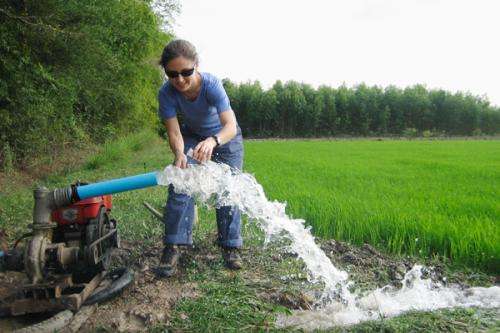Scientists find new arsenic threat in deep water wells

"Dig deep" to avoid naturally occurring arsenic contamination has been promoted as an answer to obtaining safe water in South Asia, which has experienced mass poisoning. But arsenic has been found in numerous deep wells drilled in the Mekong Delta region of southern Vietnam. Stanford Earth scientists suggest that the contamination occurs as arsenic is squeezed from ancient clay sediments surrounding the wells.
In Southern Asia, an estimated 100 million people have been exposed to risks from groundwater contaminated with naturally occurring arsenic. The tainted water, used for drinking, agriculture and industry, has resulted in a variety of serious health risks, including cancer.
Drilling deeper wells (the "dig deep" strategy) has become common in the search for clean water. But new research from the Stanford School of Earth Sciences has found that even deep wells might not remain arsenic-free.
The new research, published in Proceedings of the National Academy of Sciences, is part of ongoing efforts at Stanford to understand the extent and causes of the contamination, and to recommend precautions and solutions.
The scientists reviewed 42,000 well measurements taken throughout the multi-aquifer system of Vietnam's Mekong Delta – the southern tip of Vietnam, and the specific area of study. In an area spanning more than 1,000 square kilometers (386 square miles), arsenic was found in nearly 900 deep wells.
"Historically, deep wells often tested arsenic-free," said Laura Erban, a doctoral student in environmental Earth system science at Stanford and the lead author of the study. "However, contaminated deep wells are being reported more often in parts of West Bengal, Bangladesh, and the Red River Delta in northern Vietnam."
In some cases, the wells were contaminated when deep-pumping projects inadvertently transported shallow arsenic, or other substances that help mobilize arsenic, to greater depths.
But in the Mekong Delta, it appears there's an entirely different, and previously unsuspected, process contaminating deep wells.
When water is heavily pumped from an aquifer, surrounding clay layers compact, and water is expelled as the land sinks. If this expelled water contains substances such as arsenic, the groundwater can become contaminated. Land subsidence – the gradual sinking of land due to excessive pumping – is common in delta environments and can be measured.
"Buried clays may be analogous to 'dirty sponges,' releasing contaminated water when squeezed during pumping," Erban said.
By analyzing satellite radar observations of the area, the group found that the compaction of the clay-rich sediment has caused land subsidence of up to 3 centimeters per year. The researchers note that pumping-related land subsidence is particularly problematic in this region, much of which lies within 2 meters of sea level and is already subject to annual freshwater and saltwater flooding.
"This is the first time that satellite measurements have been used to support the occurrence of deep groundwater contamination," said Steven Gorelick, a professor of environmental Earth system science at Stanford, and co-author and project investigator of the study. "The approach can serve as a reconnaissance tool in environments prone to arsenic contamination but where well measurements may be sparse, such as economically underdeveloped regions."
Together, the ground-based data, satellite imagery and groundwater simulation model support the hypothesis that compacting deep clays is the likely cause of contamination.
"This work is a beautiful example of the application of physical data and physical reasoning to explain an apparently geochemical phenomenon," said Professor Charles Harvey of MIT, a pioneer in the study of groundwater arsenic contamination who reviewed the Stanford manuscript. "It should change how we think about pumping's effects on groundwater quality, and arsenic in particular, in a variety of sedimentary systems."
For instance, while it was previously believed that intervening layers of clay protected deep aquifers from shallow arsenic contamination, those same clays might actually pose a threat if heavy pumping causes clays to compact and in turn force arsenic into the deep aquifers. Additionally, deep wells may be compromised more quickly and extensively by contamination that originates at depth, compared with shallow sources.
The scientists suggest that the impacts of arsenic contamination from deep groundwater extraction may be reduced by quantifying the extent of deep groundwater arsenic, limiting heavy pumping and treating extracted groundwater to meet health standards.
More information: Release of Arsenic to Deep Groundwater in the Mekong Delta, Vietnam, Linked to Pumping-Induced Land Subsidence, PNAS. DOI: 10.1073/pnas.1300503110
Journal information: Proceedings of the National Academy of Sciences
Provided by Stanford University


















